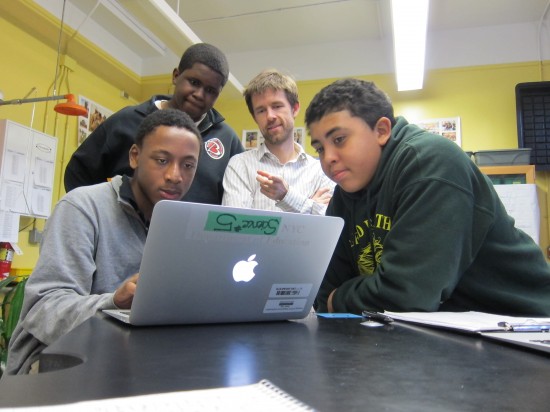
Mott Haven students build unique model green roof
Students in a Mott Haven high school science club have created a model for a new kind of green roof that keeps buildings cool, saves money on air conditioning and collects solar energy, all at the same time.
The only problem is their school can’t afford to build it.
Nathaniel Wight, 36, an ecology teacher who heads the science club at the Bronx Design and Construction Academy on E. 151st St., said it was clear from the start the school would be unable to fund the project. Constructing the solar-paneled green roof Wight and his students envision would cost hundreds of thousands of dollars, an amount well beyond the school’s budget.
“It’s not even worth talking about,” Wight said, “so we’re going the other route and trying to get external funding.”
Although the project has earned no public funding, it has received plenty of acclaim. In May of last year, two students from the club—Noel Cruz, 15, and Elton Hollingsworth, 16—presented their findings at a renewable energy forum in Denver, Colorado. Wight says his students stole the show, and the forum has invited them back.
In January, Cruz, Hollingsworth and Wight traveled to Abu Dhabi to compete in the Zayed Future Energy Prize, an international alternative energy contest. They were awarded second prize out of all competing schools from the Americas.
“That was mind-blowing,” said Cruz. “If you thought Denver was big, this was like Denver on steroids.”
It was the first time either student had traveled outside the US.
As unique as the project is, the school’s principal, Matt Williams, says it fits right in. Williams and a few of his colleagues founded the school in 2011, to replace the Alfred E. Smith Career and Technical Education High School, after the Department of Education closed that school in the same building. Williams and his peers decided to continue teaching practical skills in construction trades, as the Alfred E. Smith school had done, but with a focus on environmentally-friendly techniques.
“We believe those tools are better taught if they’re in the context of sustainability,” Williams said, pointing out the green roof as a ready example.
Although Wight was disappointed his students’ project didn’t win the $1000,000 in prize money at Abu Dhabi, he and Williams remain optimistic the club will obtain full funding for its project.
So far, Wight has had a few successes. In 2010, he and his students covered part of the school’s roof with plants, which convert sunlight into energy. A conventional roof would make the building hotter in the summertime. The group then obtained solar panels, wit funding from Columbia University, and placed the panels on the green roof.
Hunts Point-based environmental non-profit group, Sustainable South Bronx, funded the initiative.
“Usually these systems are viewed separately,” Wight said, “so it’s motivating to see if they can be brought together.”
They found that the solar panels protected the plants on the roof from the sun’s harshest rays, while the plants kept the roof up to three degrees cooler. That allowed the panels to work more efficiently.
Diana Hsueh, one of the Columbia researchers who collaborated on the project, said she had never before heard of that mutual benefit being achieved on a green roof.
“They were really excited about their work and about the science,” said Hsueh, who worked with the students on a project to determine the roof’s effects on drain water. “I could definitely feel their enthusiasm.”
In return for its support of the project, the school has allowed Columbia free use of the roof for its own green roof-related experiments, and Wight’s students help out the researchers.
Wight’s students continue collecting data on their solar panel experiments, preparing for future conferences and collaborating with Columbia on projects few other Bronx high school students get to experience.
“These kids can say they did something that wasn’t just a homework assignment. It was an original project,” said Daniel Marasco, a Columbia engineering student who worked with Wight’s students on a project, measuring how well green roofs cope with storm water.
Wight says he’s considering several grant possibilities, and is hopeful his students will win first place at the next Zayed Prize in Abu Dhabi.
“We might have to do it in pieces—get grants for different parts of the roof, and gradually cover the whole roof,” he said. “It’ll happen. We’ll fund it one way or another.”


[…] Nathan Pace for highlighting our efforts in this recent Mott Haven Herald article “High Schoolers Harness Sun’s Power“! Share this:TwitterFacebookLike this:Like Loading… By Mr. Wight […]
[…] Nathan Pace for highlighting our efforts in this recent Mott Haven Herald article “High Schoolers Harness Sun’s Power“! Like this:Like Loading… This entry was posted in Student Resources. Bookmark the […]